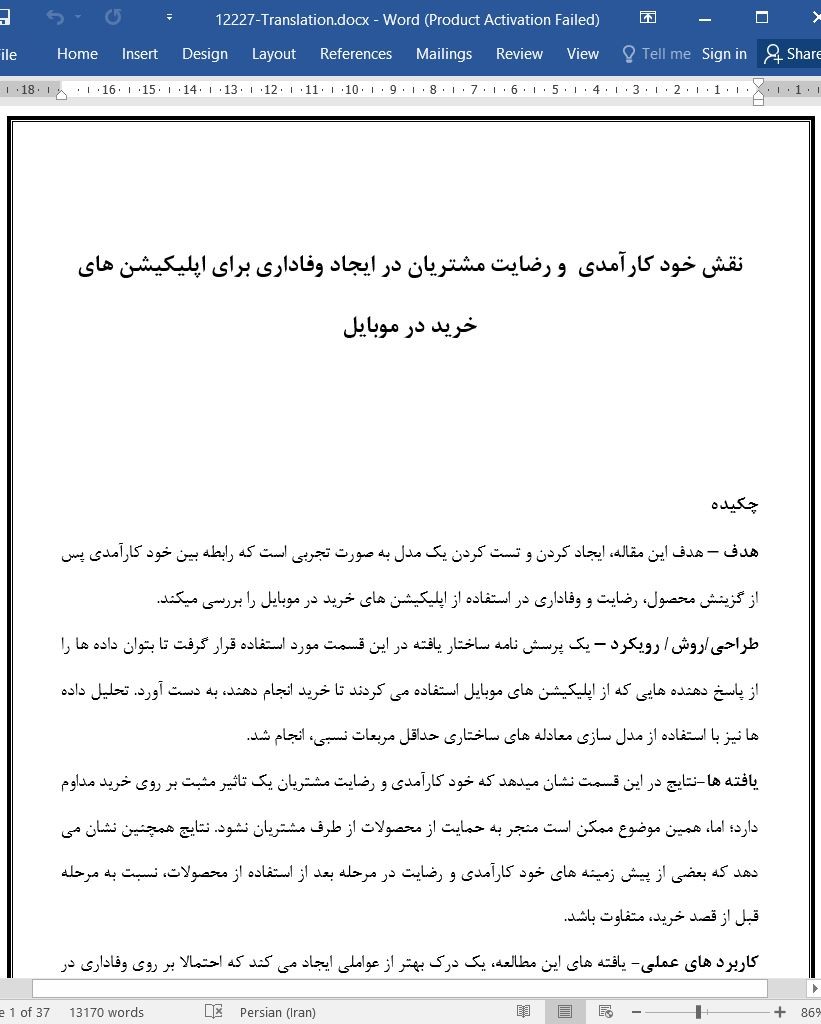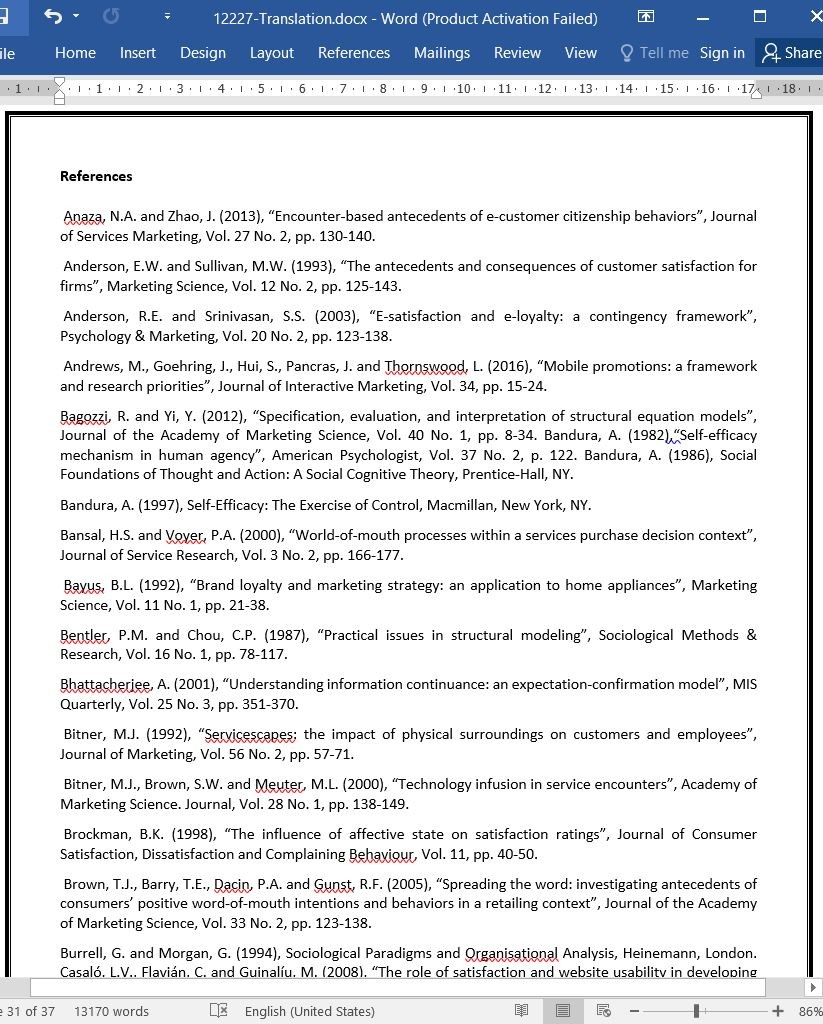
نقش خود کارآمدی و رضایت مشتریان در ایجاد وفاداری برای اپلیکیشن های خرید
چکیده
هدف – هدف این مقاله، ایجاد کردن و تست کردن یک مدل به صورت تجربی است که رابطه بین خود کارآمدی پس از گزینش محصول، رضایت و وفاداری در استفاده از اپلیکیشن های خرید در موبایل را بررسی میکند.
طراحی/روش/ رویکرد – یک پرسش نامه ساختار یافته در این قسمت مورد استفاده قرار گرفت تا بتوان داده ها را از پاسخ دهنده هایی که از اپلیکیشن های موبایل استفاده می کردند تا خرید انجام دهند، به دست آورد. تحلیل داده ها نیز با استفاده از مدل سازی معادله های ساختاری حداقل مربعات نسبی، انجام شد.
یافته ها-نتایج در این قسمت نشان میدهد که خود کارآمدی و رضایت مشتریان یک تاثیر مثبت بر روی خرید مداوم دارد؛ اما، همین موضوع ممکن است منجر به حمایت از محصولات از طرف مشتریان نشود. نتایج همچنین نشان می دهد که بعضی از پیش زمینه های خود کارآمدی و رضایت در مرحله بعد از استفاده از محصولات، نسبت به مرحله قبل از قصد خرید، متفاوت باشد.
کاربرد های عملی- یافته های این مطالعه، یک درک بهتر از عواملی ایجاد می کند که احتمالا بر روی وفاداری در میان مشتریانی که از اپلیکیشن های موبایل برای خرید استفاده می کنند، تاثیر دارد.
ارزش/اصالت – تاثیر این مقاله در راستای کشف تفاوت های بین مدل های انتخاب مشتریان در مرحله های قبل از گزینش و بعد از گزینش برای اپلیکیشن های خرید موبایل می باشد. علاوه بر این، این مطالعه نشان دهنده نقش عامل شناختی از خود کارآمدی در وفاداری در مرحله بعد از گزینش محصول می باشد که به صورت غالب، همراه با عامل احساسی از رضایت، مورد بررسی قرار گرفته است.
1. مقدمه
قرن بیست و یکم، شاهد یک تغییر الگو در صنعت خرده فروشی بوده است زیرا تکنولوژی های مبتنی بر وبسایت، توسعه بسیار سریعی داشته اند. خرده فروشی های قدیمی حالا بر اساس ظهور خرده فروش های بسیار فعال به صورت الکترونیکی که باعث تغییر حوزه و کسب و کار در دهه اول این قرن شده اند، تلاش دارند تا وارد حوزه خرده فروشی الکترونیکی بشوند. دهه دوم، شاهد ظهور خرید با موبایل می باشد که در واقع ظاهر جدید خرید الکترونیکی می باشد. خرده فروش های آنلاین به صورت روز افزون، به دنبال هدف گیری کاربران گسترده تلفن های هوشمند هستند تا بتوانند حوزه دسترسی خودشان را به صورت موثر، با سرمایه گذاری های گسترده در ارتقای خرده فروشی با موبایل، توسعه دهند. اپلیکیشن های موبایل و یا اپ های موبایل، در حال تغییر دنیای خرده فروشی هستند. یک اپ موبایل مشابه با یک فروشگاه مجازی خرده فروشی می باشد. خرده فروشان به صورت گسترده در حال افزایش استفاده از اپ های موبایل برای توسعه مشتریان در سال های اخیر بوده اند. اولین استفاده از خرده فروشی با موبایل و تکنولوژی های مشابه در زمینه های مختلف، باعث شده که محققان مختلف از سراسر جهان توجهشان به این موضوع و تکنولوژی های مشابه، جذب شود (Bitner et al., 2000; Curran and Meuter, 2005). در مورد اپ های موبایل، فراتر از آزمایش های اولیه که بر اساس بازگشت وجه خرید، کوپن های آزمایشی، پیشنهاد های خاص موبایل ایجاد شد، حالا این نیاز ایجاد شده است که ما تجارب مشتریان که در واقع عوامل توانمند ساز و موثر در استفاده دائم از این اپ های موبایل هستند را درک کنیم. رفتار مشتریان بعد از گزینش اپلیکیشن برای استفاده از آن به عنوان بستر خرید، هنوز به صورت بسیار گسترده دچار کمبود تحقیقاتی می باشد ((Taylor and Levin, 2014). با افزایش تمرکز بر روی وفاداری مشتریان، ما باید عوامل توانمند کننده و چالش های موجود در توسعه وفاداری در استفاده از اپ های موبایل در میان مشتریان را بررسی کنیم.
Abstract
Purpose The purpose of this paper is to develop and empirically test a model that examines the relationship between post-adoption self-efficacy, satisfaction, and loyalty in the usage of mobile shopping applications.
Design/methodology/approach A structured questionnaire was used to collect data from respondents who had used mobile shopping applications to make purchases. Data analysis was done using partial least square structural equation modelling.
Findings The results show that self-efficacy and satisfaction have a positive impact on continuance intention; however, the same may not lead to advocacy. The results also show that some antecedents of self-efficacy and satisfaction at the post-adoption stage differ from the pre-adoption intention stage.
Practical implications The findings of the study provide a better understanding of the factors likely to influence loyalty among customers using mobile shopping applications. The findings also provide valuable insights into the factors that e-retailers need to focus to build self-efficacy among their customers using mobile interface.
Originality/value The contribution of the paper lies in eliciting the differences between customer choice model at the pre-adoption and post-adoption stage for mobile shopping. Furthermore, the study demonstrated the role of a cognitive factor of self-efficacy in loyalty at the post-adoption stage that is pre-dominantly researched with affective factor of satisfaction.
1. Introduction
The twenty-first century has seen a paradigm shift in the retail industry by rapid diffusion of web-based technologies. Brick and mortar retailers venturing into e-retail followed by the emergence of pure-play e-retailers changed the retailing landscape in the first decade. The second decade is witnessing the emergence of m-shopping as the new avatar of online retailing. Online retailers are increasingly targeting avid users of smartphones to expand their reach effectively by making huge investments in promoting mobile retail. Mobile applications, or “mobile apps”, are transforming the retail world. A mobile app is similar to a virtual store of that retailer. Retailers have been aggressively promoting usage of mobile apps to their customers in recent years. Initial adoption of mobile retailing and similar technologies in various domains has received considerable attention from researchers across the world (Bitner et al., 2000; Curran and Meuter, 2005). In case of mobile apps, beyond the initial trials, which were led by cash backs, trial coupons, mobile-only offers, there is a need to understand customer experiences acting as enablers and deterrents in continuance usage of mobile apps. The post-adoption customer behaviour towards mobile apps for shopping remains largely unexamined in the academic literature (Taylor and Levin, 2014). With the increasing focus on customer loyalty, it is important to understand the enablers and challenges in fostering loyalty in using mobile apps among customers.
چکیده
1. مقدمه
2. مروری بر مقالات
2.1 زیربنای نظری وفاداری مشتریان
2.2 خرده فروشی موبایل
2.3 توسعه فرضیه و مدل مفهومی
2.3.1 رضایت و خودکارآمدی
3. روش تحقیق
3.1 معیار ها و ابزار تحقیق
3.2 زمینه های تحقیقاتی
3.3 فرایند و شرکت کننده های تحقیق
4 تحلیل داده ها و نتایج
4.1 مدل های اندازه گیری
4.2 مدل ساختاری
4.2.1 ضریب تعیین (R2) و ارتباط پیش بینی Stone-Geisser (Q2)
5. مباحث، کاربرد ها و محدودیت ها
5.1 یافته ها
5.2 کاربرد های نظری
5.3 کاربرد های مدیریتی
5.3.1 ساختار های اصلی
5.3.2 متغیر های کنترل
5.4 محدودیت ها و جهت های تحقیقاتی برای آینده
منابع
Abstract
1. Introduction
2. Literature review
2.1 Theoretical underpinning of customer loyalty
2.2 Mobile retailing
2.3 Hypothesis development and conceptual model
2.3.1 Satisfaction and self-efficacy
3. Research methods
3.1 Measures and research instrument
3.2 Research context
3.3 Research procedures and participants
4. Data analysis and results
4.1 Measurement model
4.2 Structural model
4.2.1 Coefficient of determination (R2 ) and Stone-Geisser’s predictive relevance (Q2 ).
5. Discussion, implications, and limitations
5.1 Findings
5.2 Theoretical implications
5.3 Managerial implications
5.3.1 Main constructs
5.3.2 Control variables
5.4 Limitations and directions for future research
References
- اصل مقاله انگلیسی با فرمت ورد (word) با قابلیت ویرایش
- ترجمه فارسی مقاله با فرمت ورد (word) با قابلیت ویرایش، بدون آرم سایت ای ترجمه
- ترجمه فارسی مقاله با فرمت pdf، بدون آرم سایت ای ترجمه



